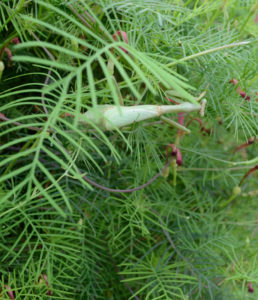You WANT Insects in Your Vegetable Garden
The lack of prolonged cold in Central Texas means that insects and other bugs don’t die out over the winter. This creates a varied and active ecosystem all year long that must be part of your vegetable growing plan. No amount of insecticide will eliminate pest problems. In many cases, pesticide use may throw everything so off balance that the problems may become worse. The best practices for managing Texas vegetable garden insects start with Integrated Pest Management, (IPM) and include a healthy amount of tolerance for minor levels of damage.
What is IPM?
Integrated Pest Mangement (IPM) is a process that solves pest problems while minimizing risks to people and the environment. There are four key strategies:

Stagmomantis sp. (Mantodea: Mantidae) hanging out in the Earth-Kind® demonstration garden
- Prevention – use cultural practices and plantings with genetic resistance to pests and disease
- Monitor and Identify – begin with an accurate identification by using the resource links on this page
- Set Action Thresholds – determine when damage warrants control efforts, learn to tolerate a minor level of damage
- Use Least Damaging Strategy of Control – choose effective, less risky pest controls first before turning to any type of chemical (even if it’s organic)
Insects By Name
Beneficial Insects
Assassin Bug
Big-eyed Bug
Ground Beetle
Honey Bee
Bumble Bee
Lacewing
Minute Pirate Bug
Lady Beetle
Parasitic Wasp
Paper Wasp
Potter Wasp
Praying Mantis
Chewing Insects
Beet Armyworm
Blister Beetle
Cabbage Looper
Colorado Potato Beetle
Corn Earworm
Fall Armyworm
Flea Beetle
Grasshopper
Leafminer Fly
Salt Marsh Caterpillar
Squash Vine Borer
Texas Leafcutting Ant
Tomato and Tobacco Hornworms
Tomato Pinworm
Pest By Vegetable Type
Beans
Beets
Broccoli
Cabbage
Carrots
Cauliflower
Celery
Cucumbers
- Aphid
- Cutworm
- Cabbage Looper
- Southern Corn Rootworm or Spotted Cucumber Beetle
- Leafminer Fly
- Spider Mite
- Sweet Potato/Silverleaf Whitefly
Eggplant
Greens
Honeydew
- Aphid
- Cutworm
- Cabbage Looper
- Leafminer Fly
- Southern Corn Rootworm or Spotted Cucumber Beetle
- Spider Mite
- Sweet Potato/Silverleaf Whitefly
- Thrip
Lettuce
Muskmelons
- Aphid
- Cutworm
- Cabbage Looper
- Leafminer Fly
- Southern Corn Rootworm or Spotted Cucumber Beetle
- Spider Mite
- Sweet Potato/Silverleaf Whitefly
- Thrip
Okra
Onions
Parsley
Peas
Peppers
Potatoes
Pumpkins
- Aphid
- Cabbage Looper
- Leafminer Fly
- Southern Corn Rootworm or Spotted Cucumber Beetle
- Spider Mite
- Squash Bug
- Squash Vine Borer
- Sweet Potato/Silverleaf Whitefly
Spinach
Squash
- Aphid
- Cabbage Looper
- Leafminer Fly
- Sweet Potato/Silverleaf Whitefly
- Southern Corn Rootworm or Spotted Cucumber Beetle
- Spider Mite
- Squash Bug
- Squash Vine Borer
Sweet Corn
Sweet Potatoes
Sweet Corn
- Beet Armyworm
- Cutworm
- Cabbage Looper
- Corn Earworm
- Fall Armyworm
- Leafminer Fly
- Spider Mite
- Stink Bug
- Sweet Potato/Silverleaf Whitefly
- Thrip
- Tomato and Tobacco Hornworms
- Tomato Pinworm
